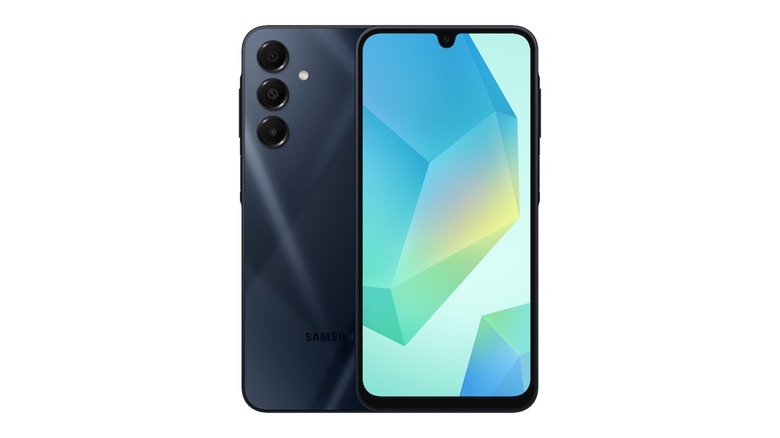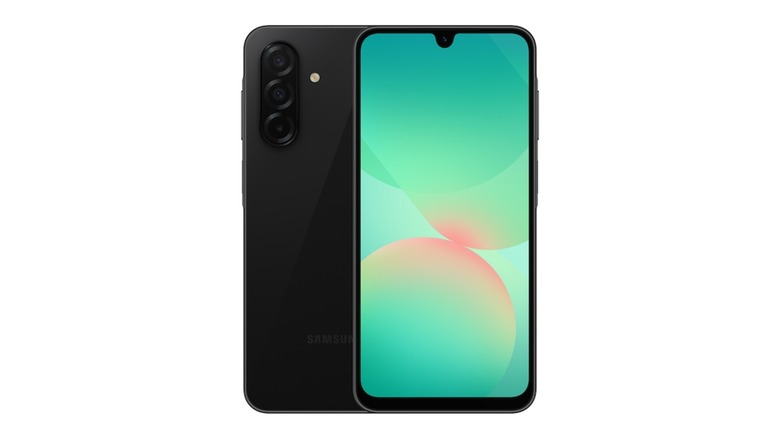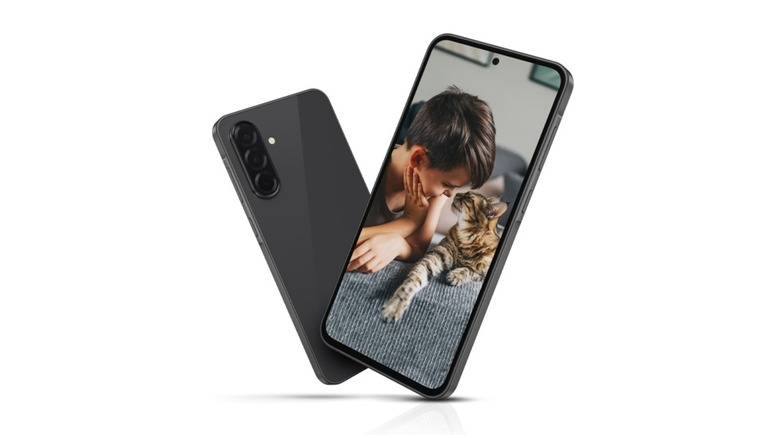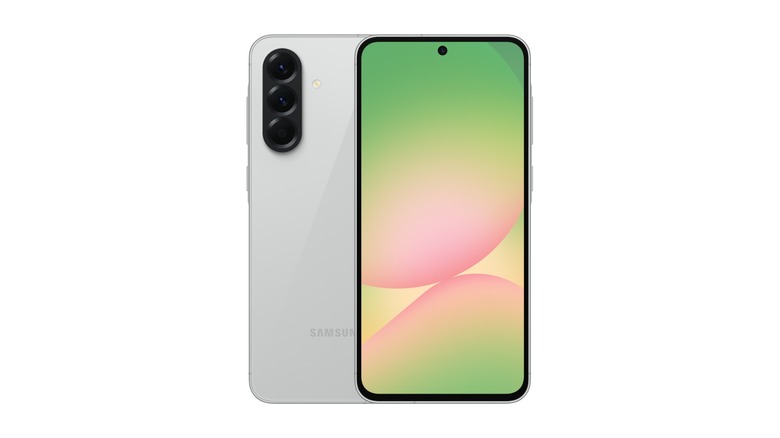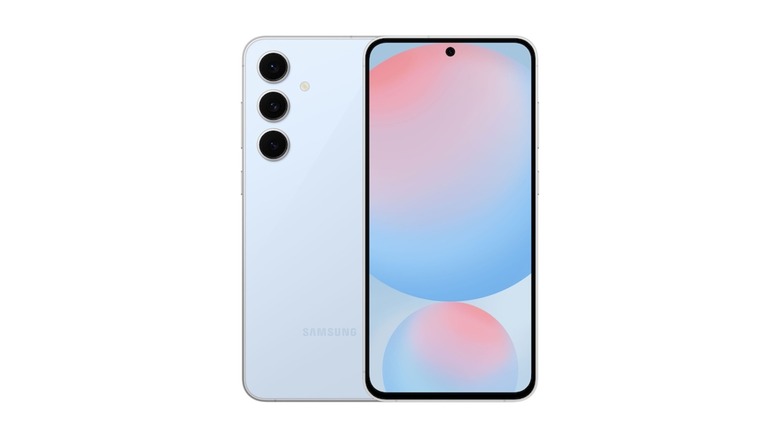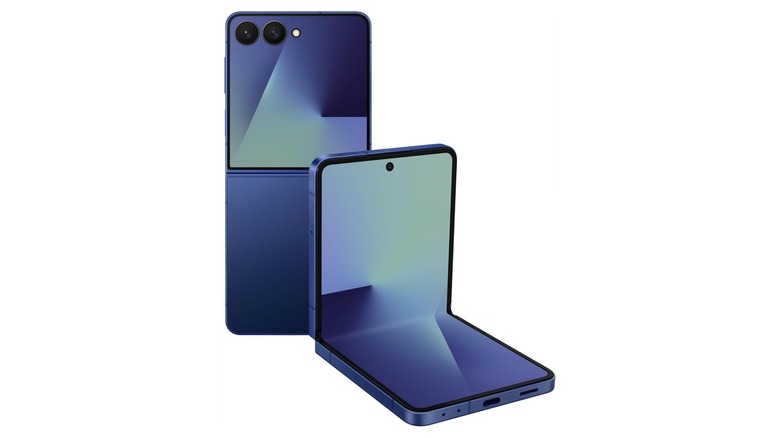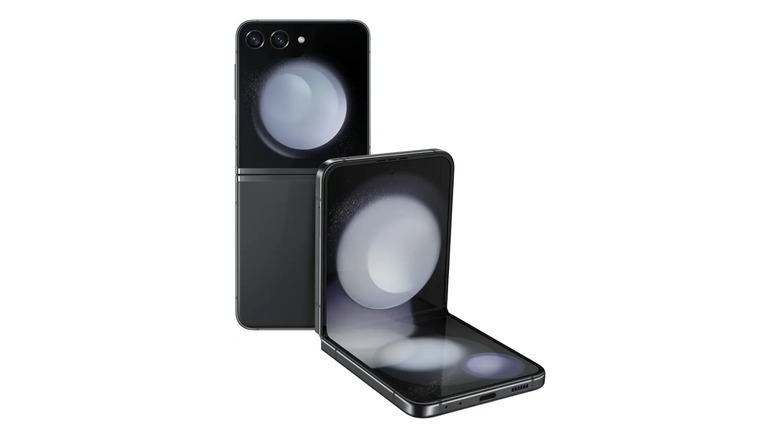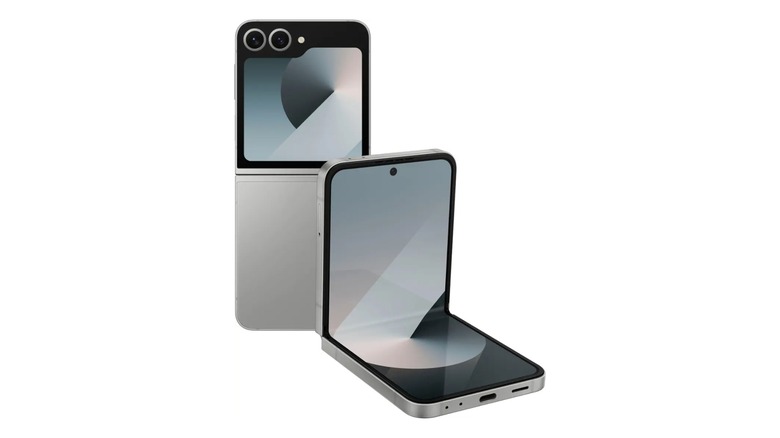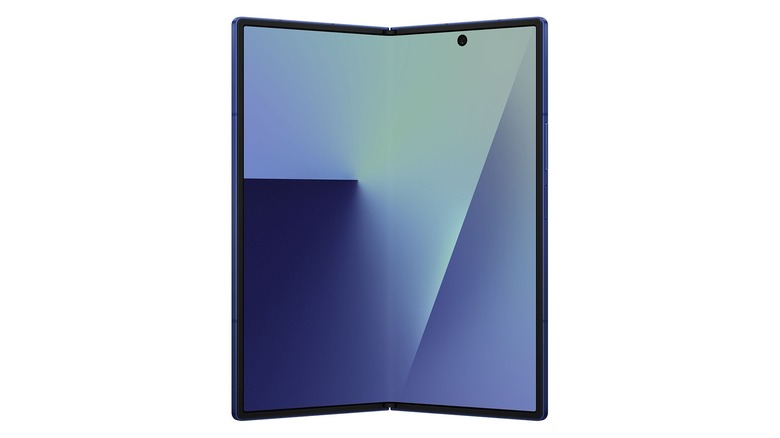Every Samsung Galaxy Phone Available In 2025, Ranked By Price
We may receive a commission on purchases made from links.
There are few smartphone brands out there that can compete with Samsung, especially when it comes to popularity. You'll find plenty of resources and recommendations regarding the best Samsung phones for every budget without much effort at all. However, there are still plenty of different models available, and that can make it difficult to truly tell which one is the best fit for you. Even if you don't want to take a risk with used devices, you won't be hurting for variety when looking at what's currently available.
Brand-new Galaxy phones can be found at places like Best Buy as well as Samsung's own store, giving you plenty of options without relying on the secondhand market. Even some older models are still around, though their prices tend to fluctuate thanks to clearances or lack of stock. There's also no guarantee they'll be available forever, as new Galaxy phones are constantly being developed. Still, it's nice to have an idea of everything you can get your hands on today, especially if some newer phone features just don't appeal to you.
A16 ($200)
The Galaxy A16 is currently the cheapest smartphone in Samsung's lineup at just around $200, providing a baseline for the rest of its models to build on. Despite this, it's still a very capable device, boasting many standard specs like FHD+ resolution, an octa-core CPU, and 128GB of storage capacity. Where it really falls short is in its lack of memory options, forcing buyers to stick with 128GB of storage and a RAM size of only 4GB. If you want to mess around with resource-intensive apps or games, the A16 will have a hard time keeping up with other Samsung Galaxy phones.
You might be able to find some versions of the Galaxy A16 with more storage and RAM capacity. However, these models are older versions that only have access to 4G LTE instead of 5G. Because of this, these additional choices are only available from third-party sellers, posing some risk even if the phones are still technically unused. With a tight budget focused on brand-new devices, you'll just have to grin and bear the low specs, but you can still make use of tips for optimizing your Android phone's RAM usage.
A26 ($300)
As you might expect, Samsung's Galaxy A26 is a step up from the A16, even if it's not by a whole lot. The biggest differences here are its 6GB RAM capacity and a slightly better set of rear cameras, allowing it to record video in 4K. Beyond that, differences are pretty minor, with both phones using very similar processors and the A26 offering minor increases in refresh rate and water resistance. The performance is quite a bit better, though, helping to justify the $100 price increase over its weaker counterpart.
Just like with the A16, you'll struggle to find any customization for the A26 in brand-new condition. Even color options are pretty limited, with only a basic black look being widely available. You can at least find some good deals for the device from various storefronts, but it doesn't change the A26's status as the second-cheapest Samsung Galaxy phone — including all the downsides that come with that label.
A36 ($400)
Despite having an upgraded processor and better brightness levels, the Galaxy A36 doesn't quite manage to justify a further $100 price increase over the A26. In fact, it actually lacks a few features, missing the microSD card slot entirely. The only way it makes up for this is by giving buyers the option to double its onboard capacity from 128GB to 256GB. Unfortunately, doing so will increase its cost by another $75, so you might as well go with the next model at that point.
The A36 is still a decent step up from Samsung's cheaper options. That performance bump can matter quite a bit when playing intensive games or simply browsing online, and it's helped by extra quality-of-life improvements like faster charging and a longer-lasting battery. It's just not very easy to recommend considering its placement as a smartphone that's only somewhat more budget-friendly. Besides, once you get further into the Samsung Galaxy "A" line, there's only one choice that can proudly boast a price tag this large.
A56 ($500)
Although the older A55 is one phone model worth buying used, the Samsung Galaxy A56 is as good as you're going to get for a "budget" smartphone. Compared to all other phones in the cheaper "A" lineup, this one has the most power and the best camera, only really lacking a microSD card slot. It also has the most available RAM at 8GB, which comes standard even if you don't opt for the $550 256GB version. Of course, $500 might not be what you have in mind when you call something inexpensive, but the A56 can easily stand out thanks to its stronger specs.
The question then becomes whether the A56 is worth it compared to other Galaxy lineups. You'll be making plenty of tradeoffs between price and performance, especially if you opt for older phones or different storage options. It might be easier to consider the A56 as a baseline when comparing other Samsung devices, as there aren't any more expensive "A" phones out there. So, just what are you getting when you pass the $500 mark?
S24 ($650-$1,300)
Samsung's "S" lineup of phones is designed for the higher end, and you can get a taste of that jump in quality with the Galaxy S24 FE. This device is priced at around $650 for its bare minimum offering of 128GB of storage, 8GB RAM, and a processor with the greatest strength yet. The S24 FE also boasts wireless charging and more color options, as well as a more versatile rear camera. Although it's a pricey purchase at $650, you can expect it to keep up with your needs for a very long time.
Unlike the previous phones on this list, the Galaxy S24 has more robust models available for a higher price. $700 will get you the non-FE version, which trades screen size for a better processor and camera, and around $1,120 will get you the S24 Plus in a 512GB configuration — a device that's harder to find brand-new, but also one with no sort of negative tradeoff. The S24 Ultra at $1,300 is even better with higher resolution and better options for storage and RAM, but these non-FE models are losing availability fast in favor of the newer S25. It's a bit of a shame, because our Samsung Galaxy S24 Ultra review praised nearly everything about the phone outside of its AI functionality.
S25 ($650-$1,300)
The latest (and arguably greatest) smartphone from Samsung is the Galaxy S25. Interestingly enough, its FE version can currently be found for the same price as the S24 FE, though it's usually $100 more expensive. Comparatively, however, it's a straight upgrade from top to bottom, even including a better battery with improved charging power. The non-FE versions are also just as much of an upgrade over their predecessor, but the regular S25 is quite a bit more expensive at $860.
The S25 Ultra is also substantially better than its predecessor, though you're more likely to find better deals on the older model. You could also opt for the S25 Edge instead, knocking $200 off the Ultra's price tag. If you're wondering how Samsung's two flagship Galaxy phones compare, you can expect the Edge to lose out on quite a bit of battery life while being comfortably more lightweight, retaining mostly similar performance and resolution. Whichever phone is "better" will come down to how flexible your budget is and which features matter most to you.
Z Flip7 ($900-$1,100)
The Galaxy Z Flip7 is one of Samsung's more unique phone offerings. The most attractive aspect is its flipping display with an extra screen mounted on top of the rear cameras. This sort of style and convenience isn't easy for any other smartphone to match, although some critics have expressed concern about inevitable creasing from the design. On the other hand, the biggest concern a buyer might have is just how capable it is, especially since its slightly weaker FE version starts at $900.
When looking at the Samsung Galaxy Z Flip7 specs, there's not a whole lot it does better than the S25. Its processor is slower, its camera is worse, and its thickness doesn't make it quite as easy to put into your pocket. Still, having the latest phone with such a special gimmick has plenty of appeal for trendy buyers and those looking to stand out from their friends. You certainly won't get a better user experience from the "A" lineup unless those creasing problems are a complete deal-breaker in the long run.
S23+ ($1,000)
For the next few items on this list, the phones shown here might look a little odd in terms of both availability and price. That's because these are all older models that have been discontinued, and their limited stock has affected costs in some very odd ways. A good example of this is the Samsung Galaxy S23, which can only be found new as the "+" version. This is priced at the same $1,000 as the S24+ and S25+, and it begs the question of whether it's truly worth looking into without a better discount.
Compared to its latest counterpart, the S23+ falls short in just about every metric. It doesn't lose by a whole lot, but aspects like the weaker processor and lower RAM capacity can be pretty harsh deal-breakers when both devices share the same price point. For as much praise as we gave the lineup in our Samsung Galaxy S23 review, newer models have simply outpaced it without skyrocketing in cost. The S23+ is a good enough phone to stick with if you already have it, but there's no sense in buying a brand-new version when the S25+ is better in just about every way.
Z Flip5 ($1,000)
Despite its age, the Galaxy Z Flip5 is still available new at the time of writing this article. However, its lack of an FE version puts its lowest cost at $1,000, and it doesn't quite manage to wear that price tag with pride. Everything about the Flip7 is either the same or a direct upgrade, with performance, RAM, and even refresh rate all surpassing the older model. Like the S23+, there isn't much of a reason to get the Z Flip5 over its successor.
The Z Flip5 reached the end of its life a while ago, so it's surprising to see it still in stock without being refurbished. Because of its absurd price and lack of benefits over newer models, it might end up staying in stock for even longer, as there just isn't much of a reason to get your hands on one right now. Even if you have one already, you wouldn't be remiss to consider upgrading to a newer model. If you wait until a deeper discount hits that puts its price closer to something like an A56, the Flip5 would actually be a decent pick, but don't hold your breath for an exceptional experience either way.
Z Flip6 ($1,100)
The Galaxy Z Flip6 is also more expensive than its Z Flip7 counterpart, at least when comparing each device's lowest available price. Right now, the Flip6 is only available from official sellers in a 512GB configuration. This has the same price as the Flip7's $1,220 512GB offering, but the Flip6 is also more widely discounted, going as low as around $1,100. Even when ignoring our glowing Samsung Galaxy Z Flip6 review, this makes it a much more compelling choice than its newer alternative.
The Flip7 might have better brightness and a more powerful battery, but the Flip6 boasts better main screen resolution and a surprisingly stronger processor. In other words, you might actually have a smoother experience on the older model than on the newer one, especially if you tend to play a lot of mobile games. Regardless of its discount, the Flip6 is still worth considering today. Just make sure you can still get it before it's gone for good.
Z Fold6 ($1,900)
Alongside the Z Flip phones, Samsung also released the Z Fold lineup, allowing them to open and close vertically rather than horizontally. This grants the obvious benefits of a much wider screen and better resolution, but it also leads to a much higher price tag. This is especially evident when looking at the Samsung Galaxy Z Fold6, which has its cheapest version set at $1,900. Compared to the Flip6, the justification for that cost will depend on what you use your phone for.
On top of the larger screen, the Fold6 has better camera capabilities and more battery life than its Flip counterpart. Meanwhile, the Flip6 has a similar processor and the same RAM capacity, letting it perform at the same level when it comes to other software. Considering how significant the upgrades have been for previously mentioned phones, it might not seem very worthwhile to go for the Fold6 instead of the Flip6. Again, it depends on personal preference, as that extra screen space will matter a lot for those who need it.
Z Fold7 ($2,000)
Today, the Z Fold7 is the most expensive Samsung Galaxy phone available, with a base price of $2,000 for its 256GB version and a maximum cost of $2,420 if you want a full terabyte of onboard storage. If you're set on a folding phone and you have money to spare, this is the one you'll want to get for yourself. It has the best camera and processor of anything in Samsung's lineup, justifying itself as the company's flagship device. Even with its lower price tag, the Fold6 just can't compete, failing to match its successor's main screen resolution.
You might be surprised to learn that the Z Fold7 is also one of Samsung's most expensive products in general. The only items that share the "Galaxy" name while being more expensive are the company's highest-end Galaxy Book laptops, with the Fold7 overtaking everything else in the company's mobile department. Its reign might not last for long, though, as there are plans for a tri-fold phone to eventually join the lineup. Until then, you can get by with plenty of cheaper options, even if they'll end up becoming obsolete by next year.

